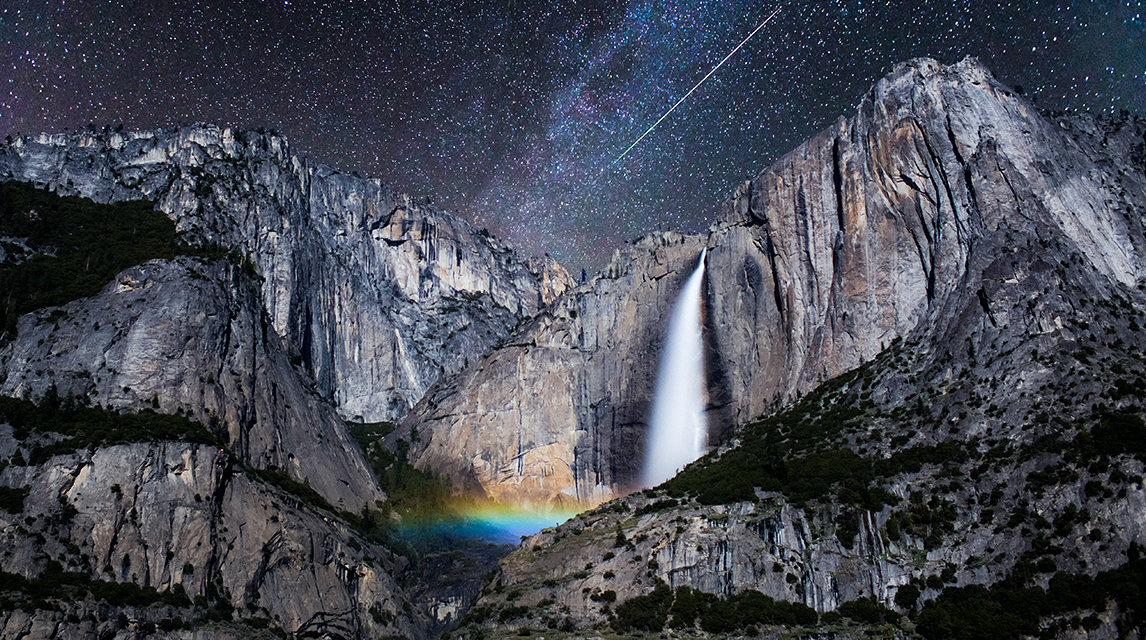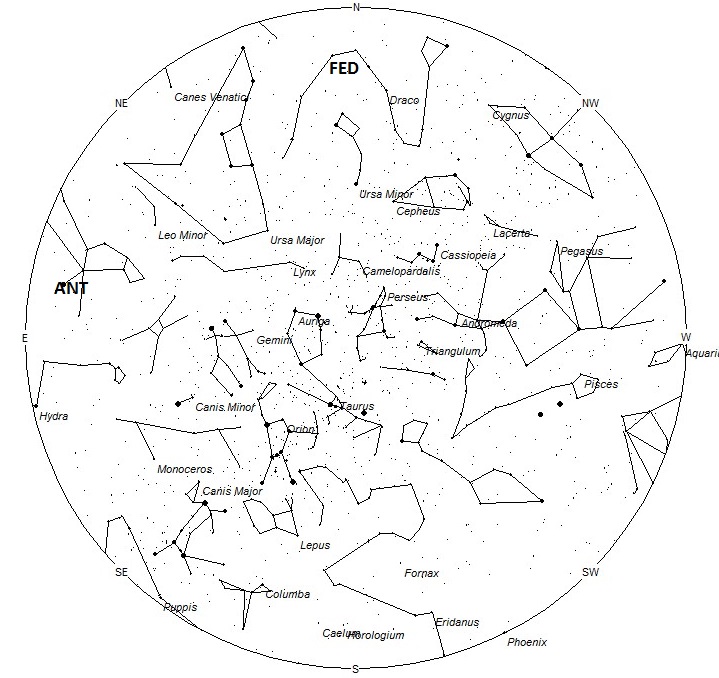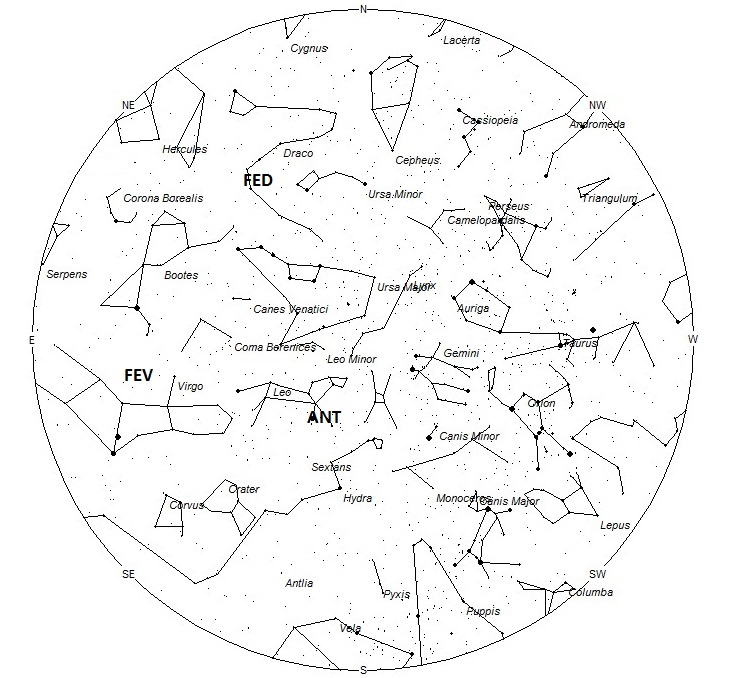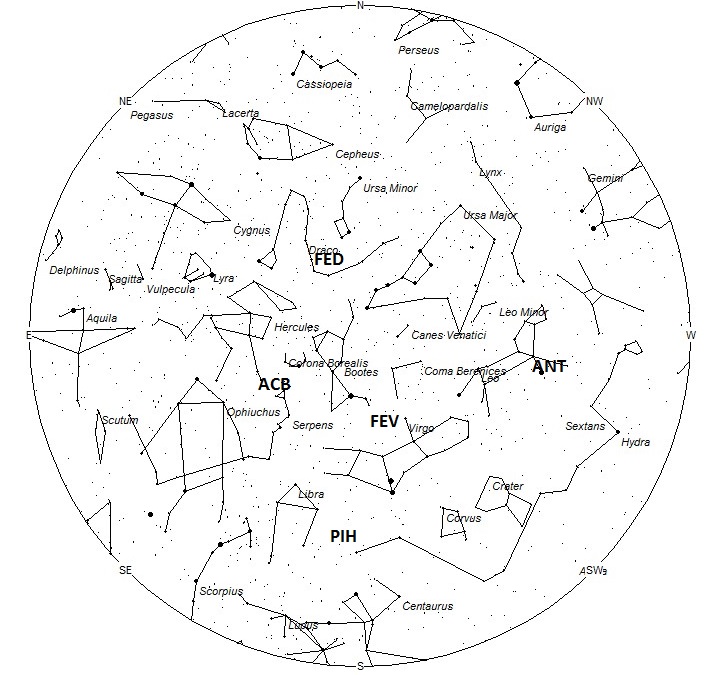
During this period the moon waxes from half illuminated to nearly full. This weekend the half-illuminated moon will set near 0200, allowing the remainder of the morning to be moon-free and prime time for meteor observing. This window of dark sky shrinks with each passing night until the moon lies above the horizon all night long at the end of the period. The estimated total hourly meteor rates for evening observers this week is near 3 for those viewing from the northern hemisphere and 4 for those located south of the equator. For morning observers the estimated total hourly rates should be near 10 as seen from mid-northern latitudes (45N) and 15 as seen from tropical southern locations (25S) Evening rates are reduced due to moonlight. The actual rates will also depend on factors such as personal light and motion perception, local weather conditions, alertness and experience in watching meteor activity. Note that the hourly rates listed below are estimates as viewed from dark sky sites away from urban light sources. Observers viewing from urban areas will see less activity as only the brightest meteors will be visible from such locations.
The radiant (the area of the sky where meteors appear to shoot from) positions and rates listed below are exact for Saturday night/Sunday morning February 4/5. These positions do not change greatly day to day so the listed coordinates may be used during this entire period. Most star atlases (available at science stores and planetariums) will provide maps with grid lines of the celestial coordinates so that you may find out exactly where these positions are located in the sky. A planisphere or computer planetarium program is also useful in showing the sky at any time of night on any date of the year. Activity from each radiant is best seen when it is positioned highest in the sky, either due north or south along the meridian, depending on your latitude. It must be remembered that meteor activity is rarely seen at the radiant position. Rather they shoot outwards from the radiant so it is best to center your field of view so that the radiant lies at the edge and not the center. Viewing there will allow you to easily trace the path of each meteor back to the radiant (if it is a shower member) or in another direction if it is a sporadic. Meteor activity is not seen from radiants that are located below the horizon. The positions below are listed in a west to east manner in order of right ascension (celestial longitude). The positions listed first are located further west therefore are accessible earlier in the night while those listed further down the list rise later in the night.
These sources of meteoric activity are expected to be active this week.
The center of the large Anthelion (ANT) radiant is currently located at 09:56 (149) +12. This position lies in western Leo, just 2 degrees west of the 1st magnitude star known as Regulus (alpha Leonis). Due to the large size of this radiant, Anthelion activity may also appear from Cancer, northwestern Hydra, and Sextans as well as Leo. This radiant is best placed near 0100 local standard time (LST), when it lies on the meridian and is located highest in the sky. Rates at this time should be near 2 per hour as seen from the northern hemisphere and 1 per hour from south of the equator. With an entry velocity of 30 km/sec., the average Anthelion meteor would be of slow velocity.
The February epsilon Virginids (FEV) were discovered by Kathryn Steakly & Dr. Peter Jenniskens using data from CAMS and SonotaCo. This shower is active from January 29-February 9, with maximum activity occurring on February 3rd. The radiant is currently located at 13:32 (203) +10, which places it in northern Virgo, 5 degrees east of the 3rd magnitude star known as Vindemiatrix (Epsilon Virginis). These meteors would be best seen near 0400 LST when the radiant lies highest above the horizon. Rates at maximum would be expected to be near 1 per hour during the last dark hour before dawn. These meteors are equally well seen from either hemisphere. These meteors encounter the atmosphere at 64 km/sec., which would produce mostly swift meteors.
The alpha Centaurids (ACE) are active from January 28 though February 21, with maximum activity occurring on February 8. The radiant is currently located at 13:46 (206) -58. This position lies in southeastern Centaurus, 4 degrees northwest of the zero magnitude star known as Hadar (beta Centauri). Due to the southern declination of this radiant, these meteors are not well seen in the northern hemisphere. Current rates are expected to be near 1 for those in the southern hemisphere and less than 1 for those located north of the equator. These meteors are best seen near 0500 LST when the radiant lies highest above the horizon. At 56 km/sec. the Alpha Centaurids would produce mostly swift meteors.
The pi Hydrids (PIH) were discovered in Dr. Peter Jenniskens and mentioned in his book Meteor Showers and their Parent Comets. Studies of the IMO video database by Sirko Molau and Juergen Rendtel confirmed the existence of this shower. These meteors are active from February 3-14, which maximum activity occurring on the 6th. At maximum the radiant is located at 14:00 (210) -21. This area of the sky is located in extreme southeastern Virgo, 6 degrees northwest of the 3rd magnitude star known as Pi Hydrae. These meteors are best seen near 0500 LST when the radiant lies highest above the horizon. Rates are expected to remain below 1, even at maximum activity. These meteors are visible over most of the Earth, with the southern hemisphere having slightly better viewing conditions. At 55 km/sec. the Pi Hydrids would produce mostly swift meteors.
The last of the Alpha Coronae Borealids (ACB) should be seen this weekend from a radiant located at 16:05 (241) +18. This position lies in eastern Hercules, 4 degrees southwest of the 3rd magnitude star known as Kornephoros (beta Herculis). These meteors would be best seen during the last dark hour before dawn when the radiant lies highest above the horizon in a dark sky. Hourly rates would most likely be less than 1 per hour. These meteors encounter the atmosphere at 57 km/sec., which would produce meteors of medium-fast velocity.
The February Eta Draconids (FED) were discovered by Dr. Peter Jenniskens and Peter Gural using data from the first CAMS network in northern California. These meteors are active on only 3 nights, February 2-5. The maximum occurs on February 3 when the radiant is located at 15:59 (240) +61. This position lies in central Draco, 3 degrees west of the 3rd magnitude star known as Eta Draconis. These meteors are best seen during the last dark hour before dawn when the radiant lies highest above the horizon in a dark sky. Expected rates would be less than 1 per hour, even at maximum. These meteors are difficult to see from the southern tropics and impossible to see from latitudes south of 30S. At 32 km/sec. the February Eta Draconids produce mostly medium-slow meteors.
As seen from the mid-northern hemisphere (45N) one would expect to see approximately 7 sporadic meteors per hour during the last hour before dawn as seen from rural observing sites. Evening rates would be near 2 per hour. As seen from the tropical southern latitudes (25S), morning rates would be near 12 per hour as seen from rural observing sites and 3 per hour during the evening hours. Locations between these two extremes would see activity between the listed figures. Evening rates are reduced due to moonlight.
| SHOWER | DATE OF MAXIMUM ACTIVITY | CELESTIAL POSITION | ENTRY VELOCITY | CULMINATION | HOURLY RATE | CLASS |
| RA (RA in Deg.) DEC | Km/Sec | Local Standard Time | North-South | |||
| Anthelion (ANT) | – | 09:56 (149) +12 | 30 | 01:00 | 2 -1 | II |
| February epsilon Virginids (FEV) | Feb 03 | 13:32 (203) +10 | 64 | 04:00 | 1 – 1 | IV |
| alpha Centaurids (ACE) | Feb 08 | 13:46 (206) -58 | 56 | 04:00 | <1 – 1 | II |
| pi Hydrids (PIH) | Feb 06 | 14:00 (210) -21 | 55 | 05:00 | <1 – <1 | II |
| alpha Coronae Borealids (ACB) | Jan 28 | 15:16 (229) +25 | 57 | 06:00 | <1 – <1 | IV |
| February eta Draconids (FED) | Feb 03 | 15:59 (240) +61 | 32 | 07:00 | <1 – <1 | IV |
 American Meteor Society
American Meteor Society



I swear I almost cried tonight because it was like a lot of meteors that you can see but the one that took my attention is a green one it’s like green and it’s like between green and white and I kept looking at it and it was moving it wasn’t a star or a nebula so I’m 100% sure that it was a meteor .
What direction do I have to face, to view the meteor shower on 2/10/2017?
Sorry I missed your post until now. The best way to see meteors is to view toward the darkest part of your sky away from any lights that may spoil your night vision.
Robert Lunsford
Looking southwest from Massachusetts, around 9:20 p.m., we saw a bright green light fall to the horizon. It was moving too fast for aircraft, had no ‘tail’, and maintained its green glow til it was out of sight. Meteorite? Satellite debris?